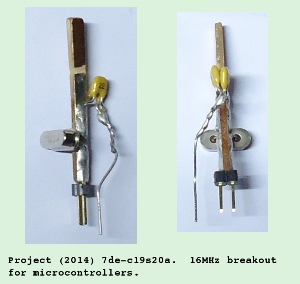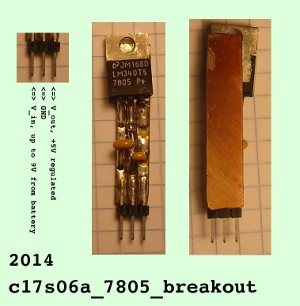05 — Fun mini-modules.
2015-02-01. By Patrick.

Fig. 1. A 16 MHz mini-module for ATmega work on breadboards.
This entry will be about small electronic 'mini-modules' that are fun to build. They don't solve any huge problem or result in greater understanding of the components. At first glance, it would seem that they're only a diversion.
By mini-modules, I mean small pieces of PCB with only three or four components and them. They're usually less than 2 cm long and 1 cm wide. Placing a 100 mil (2.54 mm) pitch header at one end allows them to be plugged directly into a standard breadboard. Figure 1 and 2 show some that I use quite often. Fig. 1 is a crystal along with two capacitors. The configuration is the typical one used by microcontrollers. Fig. 2 is a power regulator along with the two capacitors again used in a typical configuration. They are fun to build mostly because they are so fast to build and so simple.
Figure 3 is an expansion on the concept. It's a bit hard to fit a 5-element filter onto a mini-module but the idea is basically the same. I designed the module shown in the inset and made it so that one entire edge was ground. Then I tested it by connecting it with alligator clips. Later it was placed in the transmitter shown in the image by simply soldering the entire edge to the ground plane (see area circled in blue). Looking at the image carefully, it may be possible to see how this transmitter was built entirely with such larger modules.
Building one of the mini-modules takes longer than just using the components directly in a circuit. So it would seem that building them is frivolous. But after having built a number of them, I found that they provide more than a simple diversion. First, having a number around speeds breadboarding. I keep them in a box along with a print-up of the images I show here. When I look in the box, I immediately know which pin is which and what values were used. Second, they help me keep 'sub-circuits' in view when I look at complicated schematics.
So when is it time to build one? When your circuit doesn't work no matter what you try and you have been banging your head against a wall. You feel like you've tried everything and you really don't see how to move ahead. Take a small part of the project that should function as a unit. Something small enough that it's guaranteed to work. Remember, we're not trying to fix everything. We're just trying to relieve frustration while keeping the main project on the back of the mind. Build just the 'mini-module' and test it. When I've done this, I have always felt refreshed and ready to tackle the main circuit again.

Fig. 2. A 5 V voltage regulator mini-module. Super handy for breadboard work powered by a 9 V battery or requiring several voltages.

Fig. 3. One of our 80 m transmitters build with several modules. The inset shows a close-up of the filter module before it was soldered onto the base copper.